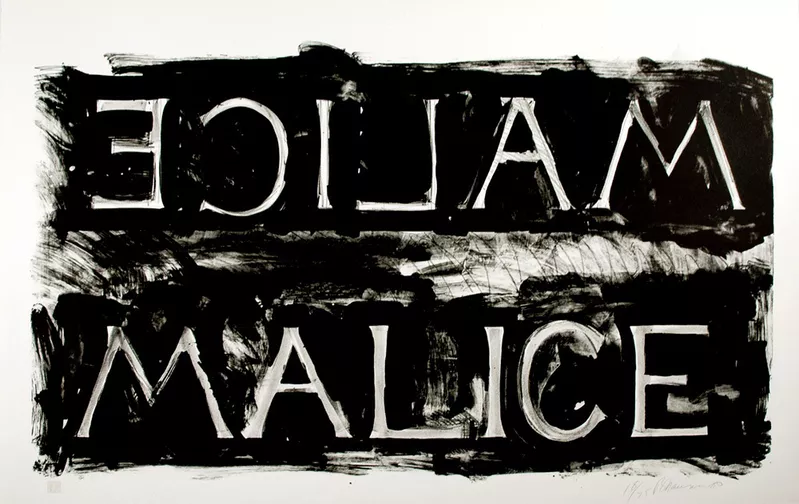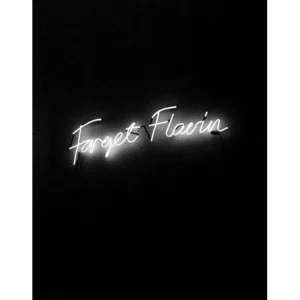
Bruce Nauman, Malice, 1980, lithograph
Darren Jones
A picture is not worth a thousand words. Nor do actions speak louder than words. Words are actions. To form a word—whether written or spoken—involves muscle, movement and energy. A word is the definition of an action. Words are the most accessible and precious tool that humankind has. Everyone has equal access to them, and can convey them in defense or attack, fondness or hate, good or ill. How one uses words to form language varies according to experience, exposure and education, but words are the egalitarian, connective tissue of society. Words have started, and ended wars; built empires, and destroyed nations. They have written what we are told is history; confirmed unions; and established laws. They have damaged, healed, killed and saved, millions of people. Words are the strongest actions ever taken. They ought to be revered, and handled with the utmost care.
But in contemporary art, words, and their potential, are being butchered—pillaged, subjugated, and bankrupted. They are deprived of context, separated from intellect, and sold into the art world black market of cheap gimmicks, and fleeting attention. They are carjacked as the vehicles for the decrepit ideas of stupid, incompetent artists, and their craven dealers, looking for post-worthy memes, and brainless likes. This assault is undermining the power of words as a mechanism for progress and beggaring their capacity for resolution, reciprocity, and understanding.
New York galleries are at the forefront of this linguistic napalm, peddling delinquent text art—usually in exhausted neon—to a guileless public, and a somnolent corps of art writers. Presently, Freight and Volume, on the Lower East Side, is hosting Anne Katrine Senstad’s solo exhibition “Hyperborea,” which includes a white, neon text that reads, “Forget Flavin.” This wretched specimen is so abjectly futile, so creatively bereft, that it seems less an artwork, and more a cowering apology for its own miserable existence. It is supposed to be an “ironic insult” to the male, minimalist patriarchy. This is a gross underestimation—the insult reaches far beyond that corner of art history. Painting isn’t dead, but neon text art is, and Senstadt is its undertaker. She has produced one of the most derivative pieces of neon text imaginable—self-satisfied, conceptually destitute, and decades late.

That Freight and Volume gave space to this atrocity highlights how severe and shameful is their dereliction of duty as stewards of linguistic art. The gallery’s press release claims that; “Working with the most elemental qualities of color, light and form, she corporealizes them into mirage-like objects that quiver between representation and perceptual experience, querying the inevitable slippage amongst our simultaneous systems of perception, sensory experience, and rational cognition.” A tornado obliterating a library would leave behind a more coherent trail of words than that schizophrenic babble.
In SoHo, Owen James Gallery is showing David Kramer’s oil, and acrylic text works, in an exhibition titled “Essential Oils.” It includes a grid of nine painted sunsets, overlaid by phrases such as “I always want more” and “this is totally a vanity project.” Most of the expressions are rendered in block lettering, and contain the pronoun “I” so that the overall effect is of the artist’s scorching narcissism, which outshines even the bright solar backgrounds. The exhibition supposedly froths with “self-deprecating humor, irony and witticisms that question the conceits of adulthood.” It’s an odd comment, considering that the immaturity on view, suggests an artist whose journey into adulthood has faltered somewhere around his middle teens. Nor—despite an exhaustive search of the gallery—is there a mote of wit or self-deprecating humor. The artist himself succinctly answers his gallery’s assertion in a square canvas, with green camouflage ground, that blares; “wrong.” This exhibition is an affront to textual ability, and the rare gift that genuine, incisive wit requires. To suggest that Kramer’s feeble puns are funny or clever is not only fantastic hubris, it is utterly false. One work reads, “Tomorrow…I start my apology tour.” They should add more dates.
Next door, at Brooke Alexander Inc, there is a presentation of text prints, by Bruce Nauman. The restrained and sombre palette is refreshing, in contrast to the gaudy installations that he’s better known for, but the work is just as facile. Scratchy black and white images, “use me,” “malice,” and “clear vision,” manage to say nothing at all, which must be a first for a collection of words. Nauman is regarded as a father of neon and text art, but his bastard progeny exemplifies how undeserved that attention is. Unoriginal, scatological and juvenile, Nauman’s nitwitted wordplay makes him text-art’s gurgling toddler, unable to comprehend the magnificence and insight that language can provide. The author of puerile drivel like “Run from fear, fun from rear,” “eat war,” and “shit and live,” Nauman’s major accomplishment has been to squander the potential of language as a communicative vessel, and diminish its scope. If Brooke Alexander Inc. were interested in developing, or enriching the practice of language as a visual medium, they would ensure that Nauman’s crass oeuvre isn’t shown again.

Far more astute and involved, but still problematic, is Andrea Bowers’s exhibition, “Think of Our Futures,” At Andrew Kreps Gallery. Its central feature is a video of a young, female activist from the Standing Rock Sioux tribe, who is opposed to the Dakota Access Pipeline, discussing sacred spaces in her ancestral landscape. Bowers’s project of highlighting environmental damage through the voices of resisters, is noble and urgent, but her ideas are weightier than her execution can manage. Unfortunately, Bowers has also made large, neon sculptures in plant and leaf motifs, that contain ecofeminist quotes. The bright, green foliage, and stark, white writing are initially appealing, but the predictable, pat slogans she has relied upon undermine the work.
Bowers’s hasn’t asked much from language, relying on peppy citations, and choir-preaching tropes, that devolve into sentimentality—“women have always thought like mountains,” “my body is not for the taking,” “resist, reuse, restore.” They may be valid battlecries, but their ubiquity, and momentum in media headlines, on demonstration placards, and as socio-political mantras, leave them superfluous as art. There is no literary comment or advancing principle here that hasn’t been produced in a newspaper to greater effect. Merely parroting well-trodden touchstones does nothing to expand their intentions, or evolve discourse. Despite her vital subject matter, Bowers’s wordy sloppiness places the work behind the curve. That isn’t where art belongs.
Over at Joshua Liner Gallery, in Chelsea, Wayne White is displaying his “sardonic wit” in “new text-based paintings that feature hand painted backgrounds.” These pieces consist of benign, sunlit cloudscapes in sherbet oranges, purplish-blues, and pinks, which White has ruined by plopping flatulent phrases on top, such as “clusterfuck,” “fuck that,” and “the fuck.” If White’s vocabulary seems rather limited, he does go beyond his profanity-laced comfort zone, stretching as far as “yes,” “no,” and “duh.” The artist believes that “humor is probably our most sacred quality. Because without it, we’re dead.” Judging by these cadavers, he’s correct. Why do so many artists, and their galleries, think that swear words, and bold capitals, equal humor and intellect? This sordid exhibition is a joke, but it isn’t amusing. A final thought from the press release, which—credit where it’s due—is hilarious. White “utilizes text to address vanity, ego, and the artist’s memories of the South.” For anyone interested, the current address of vanity and ego, is 540 West 28th Street.

Perhaps alleged text art like this can’t be expected to amount to much when its glib forbears include thoughtless, alphabetical kidnappers like Nauman, simpleton Jon Giorno (with his idiotic, multi-hued infantilism,) Allen Ruppersberg, and Ed Ruscha, but the negligence, monotony, and redundancy of today’s copycats is astonishing. The examples herein, are an accidental snapshot of one weekend in New York, but there is a constant stream of artists who insist on exposing their shriveled foresights—David Shrigley, Tavares Strachan, Ivan Navarro, Sam Durant, Alejandro Diaz, Christopher Wool, Alfredo Jaar, Josh Smith, Cary Liebowitz, and Ugo Rondinone. Not one of these textual luddites has produced anything substantial with words, yet they revel in being praised and feted by an art world too docile and unctuous to realize, or care, that it’s being duped by a parade of pictographic fraudsters who have convinced the market that a word spat onto an image represents profundity or ingenuity. Isolating a word, or a sanctimonious, belabored phrase, or making words larger or brighter, doesn’t imbue them with greater meaning; rather it advertises the conceptual poverty behind that impulse. They, and their galleries, are degrading language through their vulgarity, repetition, and frippery.
There are artists of emotional brilliance, past and present, who have employed text exquisitely, from the elegiac to the whimsical, occasionally to devastating effect—Robert Blanchon, Douglas Gordon, John Wilcox, Gary Rough, Marko Niemi, Tracy Emin, and Christopher Major, among many. Their talent lies in funneling relatable experience or observation through the filter of words, to distill life and experience into visual commentary that encourages empathy and evolvement. A few are known—most aren’t. The sensitivity with which they handle language, and craft ideas within it, coupled with their subtlety, and understated wit, leaves many of them less visible than they deserve to be, and sadly, less so than the brash, shambling underlings noted here.
New York is the crucible of this literary desolation. If galleries here want the city to retain its evaporating position at the center of American art production—or at least the perception of it—they need to reject the illegitimate textual abortions that they are currently cradling.
Darren Jones is a Scottish art critic based in the United States. His writing has been published in ArtUS, Artforum, Artforum.com, Artslant, and Artsy. He is a 2018 recipient of a Creative Capital / AndyWarhol Foundation Arts Writers Grant. He is the 2020 critic-in-residence at SPACES, Cleveland. His book, with David Carrier, The Contemporary Art Gallery: Display, Power and Privilege, was published in 2016. Jones teaches curatorial practice, at the Maryland Institute College of Art in Baltimore.

